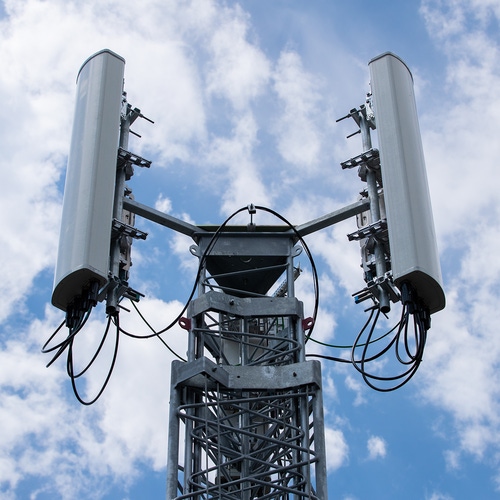
Dish Network has quietly made progress on a handful of critical elements in its quest to build a 5G network. Specifically, the company has hired a handful of additional executives to chart its network buildout, has inked contracts with cell tower owners covering an additional 4,000 transmission locations and has secured critical silicon supporting some of its spectrum bands.
Dish may also be able to take advantage of changes in Congress to add more firepower to its 5G spectrum war chest.
Overall, the moves have helped generate more support for the company among some financial analysts. "We think Dish stands to capture ~10% of the wireless market, which should warrant an equity value that is multiples of where the stock trades today," wrote the financial analysts at New Street Research in a recent note to investors.
Their comments are noteworthy considering the analysts continue to view Rakuten in Japan as a proxy for how Dish might perform in the US. Although Rakuten has struggled with its spectrum holdings and network buildout expenses, the analysts argued that the Japanese provider is helping to pave the way for Dish's 5G efforts.
"Rakuten has built the world's first virtualized wireless network, and it works," they noted. "The network delivers speeds that are competitive with 4G networks in the US today, which suggests that Dish could employ the same strategy as Rakuten to build a competitive network in the US."
Towers and builders
As for Dish's buildout efforts, the company announced Tuesday new agreements for its planned cell towers. The company said it will work with Harmoni Towers, Mobilite, Parallel Infrastructure, Phoenix Tower International (PTI), Tillman Infrastructure, Tower Ventures and Vogue Towers across more than 4,000 cell tower sites. "The vendors will also provide a variety of services to help accelerate the installation of 5G radios on the newly acquired infrastructure," Dish said.
The announcement comes just a few months after Dish agreed to lease space on up to 20,000 cell towers from Crown Castle.
Dish also recently disclosed a number of high-level hires, reporting to network construction chief Dave Mayo, that highlight the maturation of Dish's networking plans. Specifically, the company hired executives from the likes of Sprint, Ericsson and other companies to manage 5G operations in its West Region (Satish Sharma), Central Region (Nichole Thomas), South Region (Bill Watson) and Northeast Region (Mike McGovern).
Chips for devices
Dish also has quietly managed to obtain silicon to support some of the spectrum bands it owns. A Qualcomm representative confirmed to Light Reading that the company's new X65 and X62 5G modems support transmissions in Dish's Band 70 holdings. The 3GPP formally approved Band 70 in 2016; the band supports Dish's AWS-4, H Block and unpaired AWS-3 spectrum licenses.
Support by Qualcomm for Dish isn't a surprise. After all, the companies announced a 5G partnership in November. But the fact that Qualcomm has announced commercial products that support Dish's spectrum bands is an important marker in Dish's efforts to assemble an ecosystem that can support its ambitions. With Qualcomm's chips, suppliers can now potentially begin to build devices that will work in more of Dish's spectrum bands.
Finally, Dish continues to work to add more spectrum to its holdings for 5G. The company registered to participate in the FCC's recent C-band spectrum auction, although the agency has not yet released the identity of bidders in that event.
Points on the board for 12GHz
Separately, Dish is working to obtain regulatory approval to add its 12GHz holdings to its 5G arsenal. The company has been urging the FCC to issue rules that would allow 5G transmissions in the 12GHz band Dish currently uses for satellite TV, although companies including AT&T and SpaceX oppose those plans. The FCC recently agreed to investigate the topic.
A number of speakers at the recent Incompas policy summit spoke favorably about the prospect of 5G in the 12GHz band, according to Telecompetitor. And Dish itself just this week took aim at SpaceX with a study the company said shows SpaceX's Starlink low-Earth orbit (LEO) satellite system might interfere with Dish's satellite TV service in the 12GHz band.
Dish's ultimate goal is to coerce regulators into writing new rules for the 12GHz band. And, according to some financial analysts, the company may well succeed.
"We think ultimately the Democratic FCC will adopt some changes along the lines pushed by Dish. First, we note that the public interest groups, who have more influence with the Democrats than they had with the Republicans, favor the changes sought by Dish and others. Second, we think Democrats will want to put 'points on the board' for allocating more spectrum for next generation uses and this is an obvious target for doing so," financial analysts at New Street Research wrote in a recent note to investors. "We just don't think it will happen quickly. We expect a two-stage process that initially focuses on how to achieve coexistence with incumbents, followed up by technically detailed proposed rules. That could take more than a year."
Such a development would be important to Dish because it would allow the company to broadcast its 5G signal across more spectrum. In general, the number of customers a carrier can support and the speeds it can provide are closely tied to the amount of spectrum it owns. The more spectrum it has, the better its network is.
Related posts:
— Mike Dano, Editorial Director, 5G & Mobile Strategies, Light Reading | @mikeddano
About the Author(s)
You May Also Like












